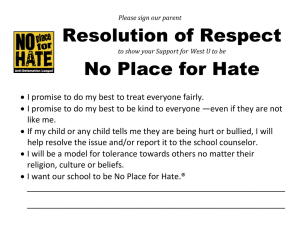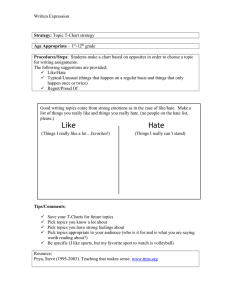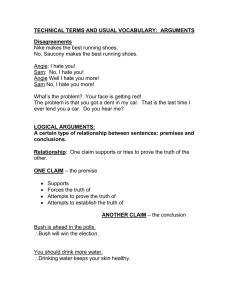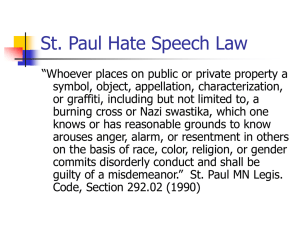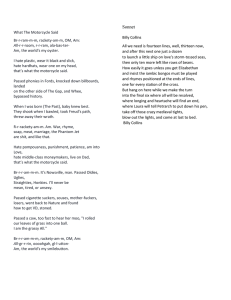HATE by Robert M. Young
advertisement
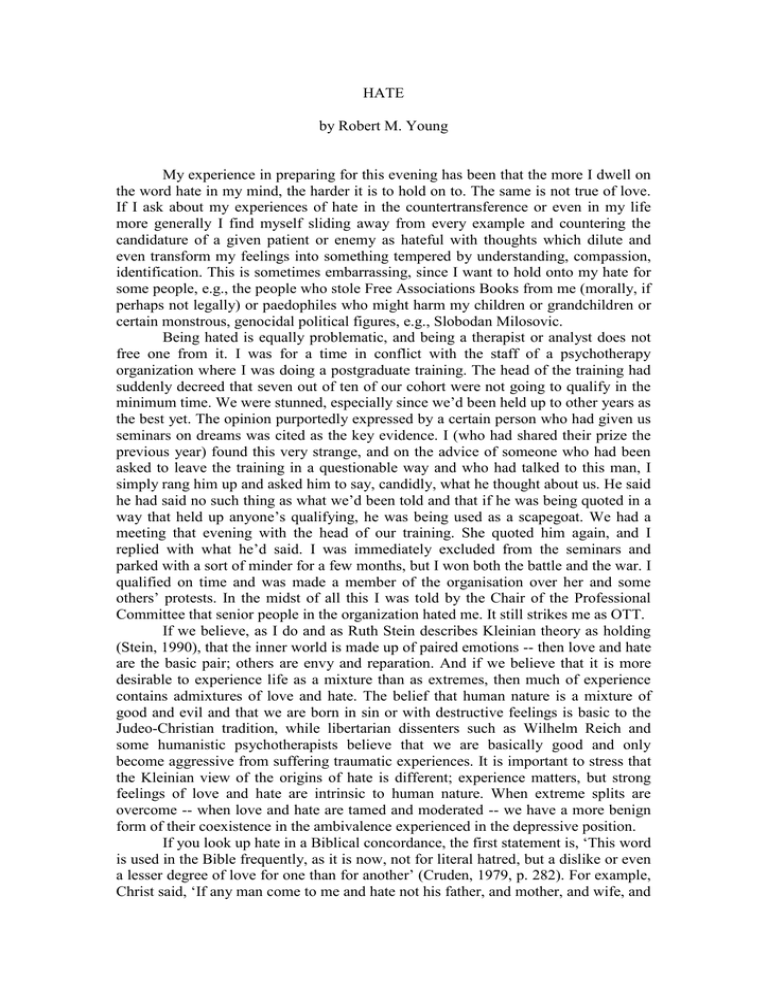
HATE by Robert M. Young My experience in preparing for this evening has been that the more I dwell on the word hate in my mind, the harder it is to hold on to. The same is not true of love. If I ask about my experiences of hate in the countertransference or even in my life more generally I find myself sliding away from every example and countering the candidature of a given patient or enemy as hateful with thoughts which dilute and even transform my feelings into something tempered by understanding, compassion, identification. This is sometimes embarrassing, since I want to hold onto my hate for some people, e.g., the people who stole Free Associations Books from me (morally, if perhaps not legally) or paedophiles who might harm my children or grandchildren or certain monstrous, genocidal political figures, e.g., Slobodan Milosovic. Being hated is equally problematic, and being a therapist or analyst does not free one from it. I was for a time in conflict with the staff of a psychotherapy organization where I was doing a postgraduate training. The head of the training had suddenly decreed that seven out of ten of our cohort were not going to qualify in the minimum time. We were stunned, especially since we’d been held up to other years as the best yet. The opinion purportedly expressed by a certain person who had given us seminars on dreams was cited as the key evidence. I (who had shared their prize the previous year) found this very strange, and on the advice of someone who had been asked to leave the training in a questionable way and who had talked to this man, I simply rang him up and asked him to say, candidly, what he thought about us. He said he had said no such thing as what we’d been told and that if he was being quoted in a way that held up anyone’s qualifying, he was being used as a scapegoat. We had a meeting that evening with the head of our training. She quoted him again, and I replied with what he’d said. I was immediately excluded from the seminars and parked with a sort of minder for a few months, but I won both the battle and the war. I qualified on time and was made a member of the organisation over her and some others’ protests. In the midst of all this I was told by the Chair of the Professional Committee that senior people in the organization hated me. It still strikes me as OTT. If we believe, as I do and as Ruth Stein describes Kleinian theory as holding (Stein, 1990), that the inner world is made up of paired emotions -- then love and hate are the basic pair; others are envy and reparation. And if we believe that it is more desirable to experience life as a mixture than as extremes, then much of experience contains admixtures of love and hate. The belief that human nature is a mixture of good and evil and that we are born in sin or with destructive feelings is basic to the Judeo-Christian tradition, while libertarian dissenters such as Wilhelm Reich and some humanistic psychotherapists believe that we are basically good and only become aggressive from suffering traumatic experiences. It is important to stress that the Kleinian view of the origins of hate is different; experience matters, but strong feelings of love and hate are intrinsic to human nature. When extreme splits are overcome -- when love and hate are tamed and moderated -- we have a more benign form of their coexistence in the ambivalence experienced in the depressive position. If you look up hate in a Biblical concordance, the first statement is, ‘This word is used in the Bible frequently, as it is now, not for literal hatred, but a dislike or even a lesser degree of love for one than for another’ (Cruden, 1979, p. 282). For example, Christ said, ‘If any man come to me and hate not his father, and mother, and wife, and children, and bretheren and sisters, yea and his own life also, he cannot be my disciple’ (Luke 15: 26). Christ clearly means in this verse that if one does not love Him more than any of these, one cannot be a disciple. I’ll add one more theological thought. In a study of the origins of the concept of Satan, the historian of theology, Elaine Pagels, traces the concept of the Devil to the otherness of tribes, which are perceived as threats to one’s own (Pagels, 1995). Psychoanalysis, especially Freudian and Kleinian psychoanalysis, fall within the Judeo-Christian framework, as many scholars have argued, for example, Philip Rieff’s Freud: The Mind of the Moralist (1960) and David Bakan’s Freud and the Jewish Mystical Tradition (1958). As a theory falling within that tradition psychoanalysis holds that we have at bottom dual natures, loving and destructive, and that hatred plays an important part in our inner worlds. The Judeo-Christian account of our humanity places hate very early in the story. Cain, one of the first two sons of the first humans, killed his brother Abel, and when asked by God where Abel was, replied, ‘Am I my brother’s keeper?’ The reason for the first murder was that God had appreciated Abel’s offering more than Cain’s, and he could not bear this. We are said to have inherited a universal tendency towards sin from Adam and Eve, and St. Paul added the concept of original sin, whereby we all partake of their disobedience of God (Romans 5: 12-19). Klein believes that the coexistence of love and hate in our natures is true from the beginning of life (Klein, 1946, p. 4) Anxiety arises from the death instinct, is experienced as fear of annihilation and takes the form of fear of persecution. The death instinct is partly projected outwards to the first external object, the mother’s breast (p. 5). Frustration strengthens hate and aggression (p. 271). Deprivation is experienced as an attack: hunger gnaws, and we retaliate with hate and aggression. In the depressive position, love and hate coexist, but love surmounts hatred, thereby promoting reparation, integration and whole object relations. In therapeutic work we have to go back again and again to the fluctuations between objects, loved and hated, external and internal, which dominate early infancy (p. 53) Positive and negative transference involve the interplay between early love and hate (ibid.). It is these that we interpret and work through. The writings of Harold Searles are a particularly helpful place to look at hatred, because he writes so vividly and honestly about his own primitive processes and about the extreme emotions that his patients evoke in him (Searles, 1979; Young, 1995). He is utterly candid about the projections finding a home in his own unconscious and intensifying and bringing to the surface feelings already there and not just projected into him. Indeed, he believes that there is a point in successful analytic work point, which he calls therapeutic symbiosis, when it is not at all clear whose feelings are under scrutiny or who owns them. He tells us story after story of mutual hatred and murderousness between him and his patients. He writes about a patient with whom the sessions were conducted in an atmosphere of ‘murderous hate, mutually murderous hate’ (p. 538), which he was able to overcome on one occasion by thinking of her as a schizophrenic, i.e., not as a fully human being with whom he was in a symbiotically mad relationship in which her countertransference evoked sustained and equally murderous feelings from within him. I’ll mention two of my favourite anecdotes from him. As you probably know, the Congressional Medal of Honor is America’s highest military medal. One patient said that he deserved ‘the Congressional Medal of Spit’. Another said that she only remained in the hospital to prove that he couldn’t help her. 2 As for Winnicott, the first thing to note about his famous paper on ‘Hate in the Countertransference’ (1947) is that he is writing about working with psychotics, while Klein and Searles and, of course, Bion, simply assume that we are working with psychotic parts of all our patients and of ourselves. For example, in the closing passage of the paper he locates psychotic anxieties and hatred only in the psychotic patient, where Kleinians would see these features in all of us. I find the content of what Winnicott says helpful, but his theory seems to lie somewhere between conventional, objectivist ideas about countertransference and the recent approach in which countertransference is ubiquitous and at the centre of the analytic process. Similarly, Winnicott’s concept of ‘objective hatred’ (pp. 196, 199) strikes me as suspended between an objectivist view of countertransference and the modern one, which fully embraces the centrality of it in analytic work. Irma Brenman Pick (1985) calls it the essence of the analytic relationship. Where Winnicott is right as rain, however, is in asserting that we have to own and take responsibility for our own extreme feelings, especially our hatred. On the subject of maternal ambivalence he is also spot on, including pointing out that ‘Rockabye Baby’ ends rather aggressively with the bough, baby and cradle falling down. What I have to say about my own clinical experience reflects and exemplifies what I have said about the Bible, Klein, Searles and Winnicott. My patients do project extremely aggressive and sometimes hate-filled feelings into me, and they evoke such feelings from an ample reservoir within my inner world. The trick, as Bion says, is to retain the ability to think under fire -- to contain and detoxify and eventually make sense of what is happening and give it back in a helpful, digestible interpretation and not as a retaliatory reprojection. I want to say first that I increasingly believe that containment and demeanour can be as important, and I suspect often more important, than anything clever we might say in interpretations. Winnicott thought this, too. Surviving murderous, demeaning, sarcastic, insulting, humiliating attacks assuages the patient’s primitive anxiety. I have a patient who can be excoriating, and my survival is reassuring, as long as this person knows that my goat has been well and truly got. Sometimes we fail. I can think of two patients whose violent feelings exceeded my capacity for containment. One, an obese, miserable and deeply embittered school teacher (the daughter of an abandoned and wretched mother), did finally exceed my ability to contain what she projected into me. I learned this the hard way by acting out. I unwittingly walked right past her sitting in her car a couple of minutes before her session and went off to a pub to have a good-bye drink with a departing colleague. Though I was quickly fetched back and although we did have several more sessions, this rejecting re-projection could not be repaired. Another, who claimed to detect all sorts of unforgivable true attitudes beneath my surface Politically Correct ones, e.g., sexism, chauvinism and anti-Semitism, also eventually left after the break at the end of a year’s work. Before that I twice found her unbearable enough to convey that I was prepared to let her leave. I wish I had been able to acknowledge more fully to myself the truth of her charges. Not that I was in my day-to-day life a Ku Klux Klansman or abuser (her best goading word) but that racist and sexist feelings were detectable in me, as they are in others and in her, and the problem was how to mitigate, sublimate and suppress them by means of principled behaviour, while addressing her primitive anxieties at another level. Her anxieties about not being held were always on the surface, and her distrust was ever-present, urgent and insistently accusing. No one could be trusted, so she goaded until she was satisfied 3 that she had elicited proof that her fears were well-founded, and she was very talented at doing this. Before signing off I want to point briefly to some topics which I do not have time to discuss at any length, which are central to the understanding of the manifestations of hatred and which we can consider in the discussion period. (I consider most of them at length in my book, Mental Space, (1994)). Projective identification is basic to all communication, but it has benign and virulent forms. In its virulent form, involving extreme splits, it is the common denominator in • domestic violence -- suffered by a quarter of women • criminal violence -- increasingly committed by young people • racism -- which is ubiquitous • virulent sectarianism, tribalism and nationalism -- which fill the news and blight the lives of ordinary people • perversion –- which Robert Stoller rightly calls ‘the erotic form of hatred’ In every case something violent is disowned and unconsciously projected with great force into the victim or enemy, who is attacked and demeaned for reasons unconsciously presumed to be merited and legitimate. We have here the acting out of the most primitive unconscious phantasies, the ones Klein imputed to the infant in her first description of projective identification, a mechanism that she called ‘the prototype of an aggressive object relation’ (Klein, 1946, p. 8). It involves expelling dangerous parts of the self in hatred into an object experienced as the persecutor but who is also identified with the bad self. The relationship created by projective identification is symbiotic and will continue to hold both parties until the perpetrator takes back the projection and moves from the paranoid-schizoid, involving spits, persecutory guilt and part-object relations, to the depressive position, involving the ability to bear mixed feelings, concerned and reparative guilt and whole-object relations, and experiences the other sympathetically and as also human. Virulent projective identification is the fundamental vehicle for expressing hatred. Hatred itself is a manifestation of Thanatos, the death instinct, and it is intrinsic to our natures, just as love or Eros is. Freud tells us in Civilization and Its Discontents that the constructive programme of civilization is opposed by humanity’s aggressive instinct. In his reflections on hate Freud quotes Heine in support of his critique of the credibility of the precept that one should love one’s enemies: ‘Mine is a most peaceable disposition. My wishes are: a humble cottage with a thatched roof, but a good bed, good food, the freshest milk and butter, flowers before my window, and a few fine trees before my door; and if God wants to make my happiness complete, he will grant me the joy of seeing some six or seven of my enemies hanging from those trees. Before their death I shall, moved in my heart, forgive them all the wrong they did me in their lifetime. One must, it is true, forgive one's enemies -- but not before they have been hanged’ (Freud, 1930, p 110n). Freud writes that ‘The history of civilization is the struggle between Eros and Death. It is what all life essentially consists of’ (Freud, 1930, p. 122). These matters could not, then, be more important, fundamental or inevitable. Klein says that the interaction of the life and death instincts, of love and hate, governs all of life (Klein, 1958, p. 245). When I feel hopeless about myself with respect to containing my negative countertransference I recall that a colleague once said that when he was in analysis with an eminent Kleinian training analyst (whose work I greatly admire), his 4 analyst said one day, ‘I would like to stop this session now, since I am too angry to continue this session.’ This is a comfort to me. This is the text of a talk given in the series sponsored by CONFER on The Clinical Encounter: Series One — ‘Surviving Love, Hate and Terror in the Clinical Encounter’, 20 November 1999 at the Tavistock Clinic. REFERENCES (Place of publication is London unless otherwise specified) Bakan, David (1958) Freud and the Jewish Mystical Tradition. N. Y.: Schocken; reprinted Free Association Books, 1990. Brenman Pick, I. (1985) 'Working Through in the Counter-transference', Int. J. Psycho-anal. 66: 157-66; reprinted in Spillius, ed. (1988), vol. 2, pp. 34-47. Cruden, Alexander (1979) Cruden’s Complete Concordance to the Old and New Testaments (1930), 3rd revision, edited by C. H. Irwin et. Al. Cambridge: Lutterworth Press. Freud, Sigmund (1930) Civilization and Its Discontents. S. E. 21, pp. 59-145. ______ (1953-73) The Standard Edition of the Complete Psychological Works of Sigmund Freud, 24 vols. Hogarth (S. E.). Klein, Melanie (1946) ‘Notes on Some Schizoid Mechanisms’, reprinted in Klein, 1975, pp. 1-24. ______ (1958) ‘On the Development of Mental Functioning’, reprinted in Klein, 1975, pp. 236-246. ______ (1975) Envy and Gratitude and other Essays1946-1963. Hogarth Press, 1975; reprinted Virago, 1988, pp. 1-24. Pagels, Elaine (1995) The Origins of Satan. Allen Lane: The Penguin Press. Rieff, Philip(1960) Freud: The Mind of the Moralist. Gollancz; 3rd ed., Chicago, 1979. Searles, Harold (1979) Countertransference and Related Subjects: Selected Papers. N. Y.: International Universities Press. Spillius, Elizabeth B., ed. (1988) Melanie Klein Today, 2 vols. Routledge. Stein, R. (1990) 'A New Look at the Theory of Melanie Klein', Int. J. Psycho-anal. 71: 499-511. Winnicott, Donald W. (1947) ‘Hate in the Countertransference’ reprinted in Through Paediatrics to Psycho-analysis. Hogarth Press, 1982, pp. 194-203 Young, Robert M. (1994) Mental Space. Process Press. ______ (1995) ‘The Vicissitudes of Transference and Countertransference: The Work of Harold Searles’, Free Assns. (no. 34) 5: 171-195, 1995. Copyright: The Author Address for correspondence: 26 Freegrove Road, London N7 9RQ robert@rmy1.demon.co.uk web site: http://www.human-nature.com 5

